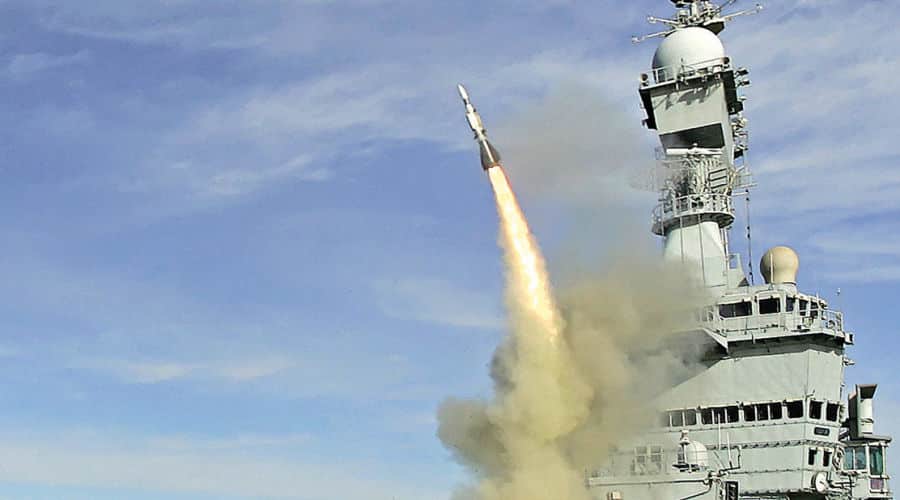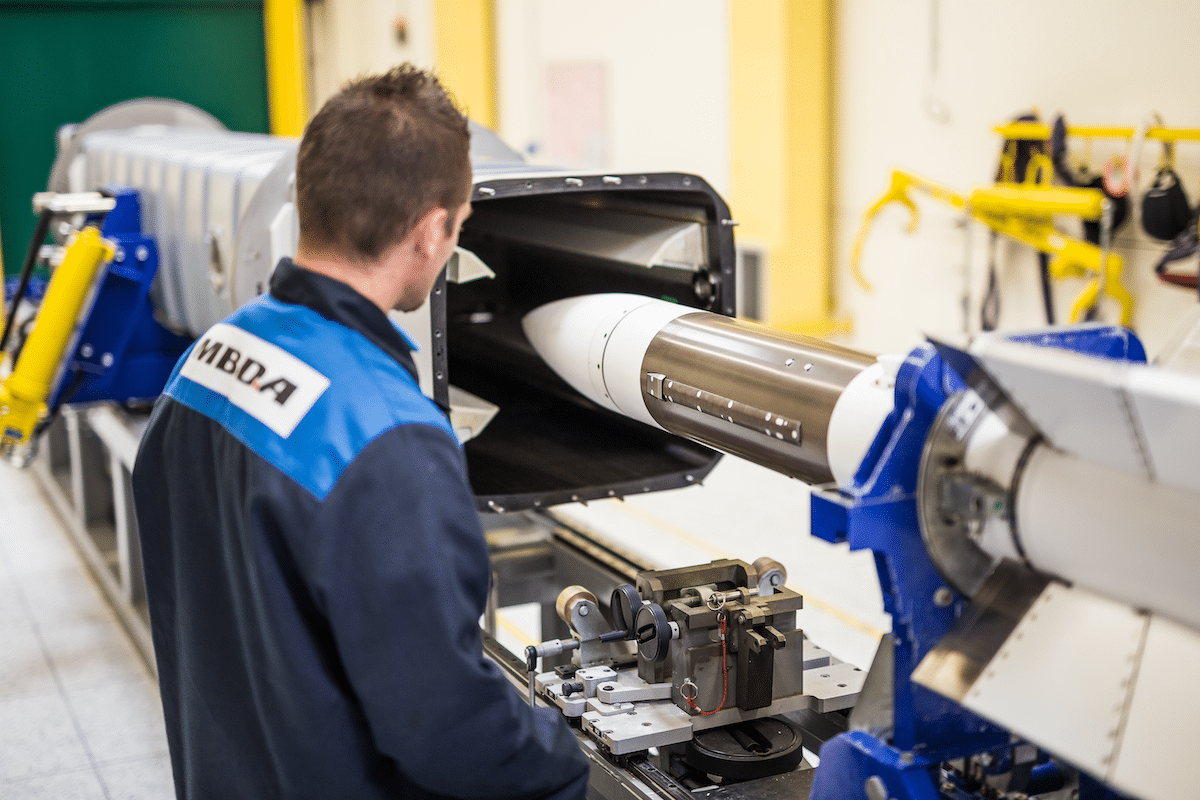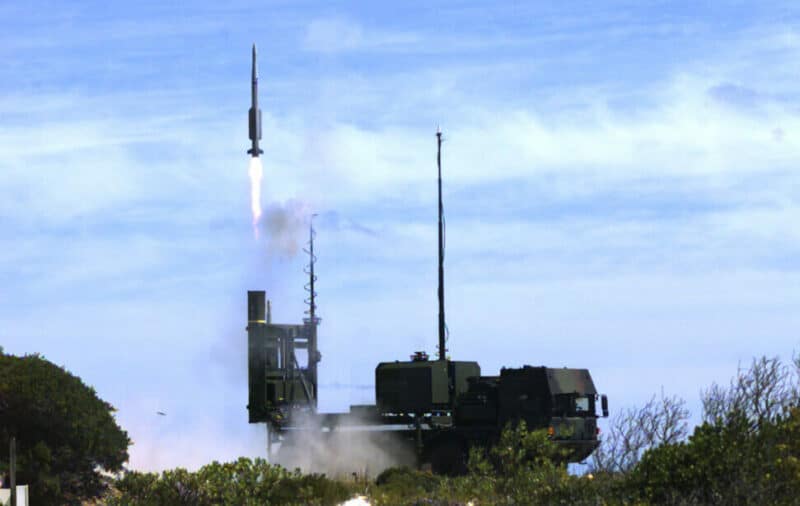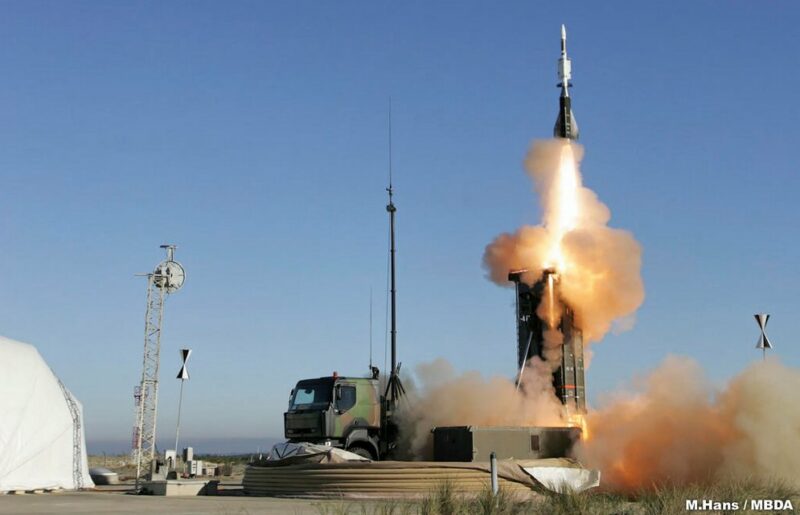The Aster missile family will soon expand, with the arrival of the Aster 15 EC. Entering service from 2001, these anti-aircraft missiles constituted a true cultural revolution in air defense. For the first time, in fact, Westerners were able to rely on a non-American (or Soviet) system to ensure medium and long range air defense of their sites or their ships.
The Aster range consisted of two missiles. The Aster 30, equipped with a long-range booster, allowed the missile to reach a range greater than 120 km, and an altitude of 20 km.
The Aster 15 was more compact, 4,2 meters compared to 4,9 m, and lighter, 310 kg compared to 450. Although it retained the extreme maneuverability of the Aster family, and an active radar seeker of very high efficiency, it was only given to have a range greater than 30 km, 45 km being however often mentioned by the specialist press.
At that time, other medium-range missiles only achieved a lower range, 42 km for the Russian 9M37 Buk, 40 km for the American ESSM and 30 km for the Norwegian NASAMS.
Since then, these systems have progressed significantly, and all reach 50 km range, including the ESSM, NASAMS and the German Iris-t SLM, sometimes more, 70 km for the 9M37 missile of the Buk-M3. It was therefore necessary for the Aster 15 to evolve, as the Aster 30 did with Block 0, Block 1 and Block 1NT. This is precisely what MBDA is now dedicated to.
In this section:
Meta-Defense celebrates its 5th anniversary!

- 20% on your Classic or Premium subscription, with the code Metanniv24
Offer valid from May 10 to 20 for the online subscription of a new Classic or Premium, annual or weekly subscription on the Meta-Defense website.
The excellent behavior of the Aster family in the face of Houthi drones and missiles
Although it entered service in 2001, the Aster missile had never had combat experience, until the engagements in the Red Sea beginning at the end of 2023 against Houthi drones and anti-ship missiles, and in Ukraine against missiles and drones. Russians.

The European missile had shown, until then, remarkable qualities, but during test firings and exercises, including international ones, in particular concerning the naval versions aboard frigates and destroyers of the French, Italian and even British Navies.
However, not being able to rely on the “Combat Proven” label, nor on the precedence of the European missile maker in the field of long-range anti-aircraft missiles, the Aster had a lot of difficulty establishing itself in international competitions, especially against the American Patriot, SM-2 and ESSM.
As such, the intensive use made of Aster frigates of the Royal Navy, the National Navy and the Marina Militare, against Houthi drones and cruise missiles, with an excellent success rate, marks a radical shift in the image of the missile on the international scene.
This is especially true since the French frigate Alsace has become the first European ship to successfully intercept not one, but three ballistic missiles anti-ships, propelling the Aster to the same level as the American Patriot PAC and SM-6.
The Aster 15 EC missile will take over from the Aster 15 in 2030
To respond to the evolution of the threat, and that of competition, MBDA has therefore undertaken, in 2023, to develop a new version of the Aster 15. Named Aster 15 EC, this missile must enter service in 2030, initially aboard the 4 SYLVER 43 systems of the French aircraft carrier Charles de Gaulle, on the occasion of the 3rd and last major technical shutdown of the ship, before being deployed on French frigates.

The data concerning the performances of the new missile are, for the moment, fragmentary. According to MBDA, it will have a range twice as long as that of the Aster 15, beyond 60 km, putting the missile back in the upper range of medium-range missiles. The missile's other capabilities, notably its seeker, will also evolve to respond to evolving threats and their defense capabilities.
We can also think that if the Aster 15 sees its range increased, this could also be the case, by transitivity, of the Aster 30, just as the developments which will be made to the seeker of one, will be to that of the other.
On the other hand, if the range of the Aster 15 EC is doubled compared to the Aster 15, we can assume that this will also be the case for its ceiling, which should easily reach, in this case, the 18 km, potentially allowing the missile to be used against high altitude targets, perhaps even against ballistic missiles in the final phase, benefiting, again, from the experience acquired on the Aster 30 in this area .
MBDA anticipates renewed interest in the Aster following performances in the Red Sea
Whether it is to meet the needs in Ukraine, the rise in power of the French armies and the constitution of operational reserves, and to satisfy export demand, MBDA is called, today, to considerably increase the production of its missiles, in particular Aster, Mistral 3 and anti-tank Akeron.

A few days ago, the French Minister of Defense, Sébastien Lecornu, even threatened requisition, so that the French missile manufacturer, and especially its subcontracting network, increase the production rates of the Aster missile, and the volume of production stocks, in order to guarantee sustained and uninterrupted industrial activity.
This increase in production rates is all the more crucial as the French authorities, like the missile manufacturer, anticipate a renewed interest in this weapon system, faced with the increase in global demand and the risks surrounding production. American, as well as the performances demonstrated in the Red Sea and in Ukraine, including against the ballistic threat.
This aspect has not escaped Raytheon and Lockheed Martin, which produce the Patriot, but also the ESSM and the SM-2 and SM-6. The industrialists have, in fact, published two articles in quick succession on the site DefenseNews.com, praising the Patriot, the first concerning its performancesIncluding against the Russian Kinzhal, the second for tout American industrial production capabilities around this system.
A European market blocked by the German European Sky Shield initiative
The two American giants know, in fact, that the Aster systems, whether the land SAMP/T Mamba or the naval PAAMS, had until then suffered from an image deficit compared to competing American systems, effectively worked by manufacturers and opinion relays in the US, including in Europe.
The SAMP/T Mamba nevertheless had very attractive costs, and anti-aircraft and anti-ballistic capabilities comparable, sometimes superior, to those of the Patriot, including a radar offering 360° coverage, compared to 120° for the Patriot until the upcoming arrival of the AN/MPQ-65 radar. However, the system has never found a buyer, outside of France and Italy, at least until now.

For several months, however, the system delivered to Ukraine by Rome and Paris, and the Aster 15 and 30 of European frigates and destroyers, have largely shown their great effectiveness, against a vast number of different targets, ranging from drone to ballistic missile attack, including anti-ship or supersonic cruise missiles.
MBDA, like Eurosam, the joint venture formed by MBDA, Thales and Leonardo, which build the Aster and the Mamba, are now in a position of strength to try to impose the system, including in Europe.
To achieve this, however, it will be necessary to obtain from Berlin that the SAMP/T joins the European Sky Shield Initiative program, launched by Olaf Scholz in 2022, and which already brings together 20 countries, and should soon include 22 with the arrival of Greece and Turkey.
In this area, the arrival of the Aster 15 EC will not simplify the task for French and Italian negotiators. Indeed, with a range extended to more than 60 km, the missile clearly outperforms the German IRIS-T SLM, which only reaches 40 km, which should precisely become the pillar of the ESSI, while the Aster 30 has demonstrated its anti-ballistic effectiveness, and that the Aster Block 1NT arrives to surpass the Patriot PAC-3 in this area.
It could well be, in these conditions, that the Franco-Italian Mamba, once approved within the ESSI, will quickly establish itself as a European standard, to the great dismay of Berlin and the United States, for whom the he initiative constituted a very effective stepping stone to take control of European anti-aircraft defense.
We can well imagine, in these conditions, the lack of enthusiasm of the Germans, and the American lobbying, to prevent the arrival of France and Italy, and especially of the SAMP/T Mamba and the Aster, within of the ESSI program.
Article from April 11 in full version until May 19



Small typo towards the end it's the fault of Franco-Italian and not German. ^^
Mamba*
A typo... read Mamba Franco-Italian.
“It could well be, under these conditions, that the Franco-Italian (and not Franco-German) Mamba, once approved within the ESSI, will quickly establish itself as a European standard, to the great dismay of Berlin and of the United States, for whom the initiative constituted a very effective stepping stone to take control of European anti-aircraft defense. »
But is it in the pipeline for France to integrate the German initiative? Because she was not keen at the start but given the arguments cited, clearly there is considerable interest in turning the German initiative against her.
I know discussions are taking place. But this is not going to be simple, because for France (and Italy) to join the ESSI, it is obvious that Berlin will have to agree to integrate the SAMP/T, as well as the MICA VL NG. And as said in the article, this is not going to work, but not at all, in the interest of Berlin, nor of Washington. In my opinion, we will have to wait until Scholz leaves for this to come to fruition.